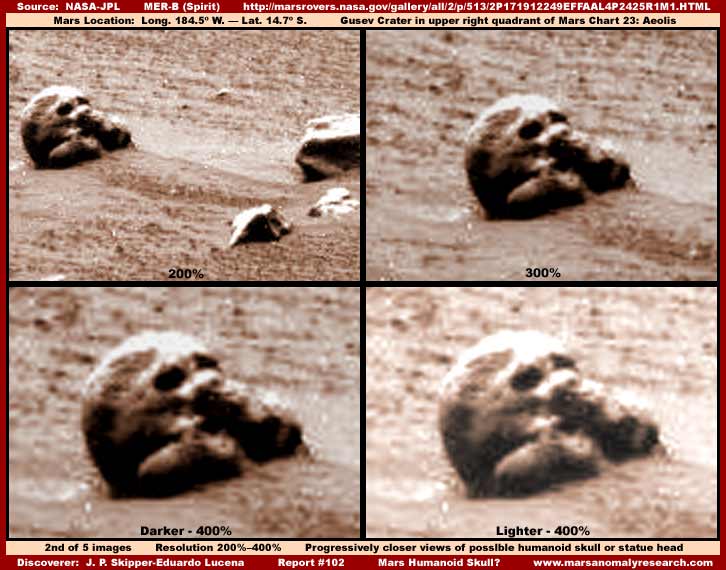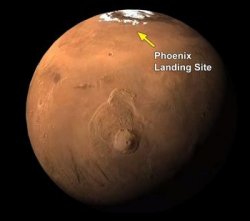Foi um rumor:
The Phoenix flap
By Emily Lakdawalla
I love the Internet. Sitting here at home, I am hooked in to a worldwide network consisting of scientists and engineers working on active missions; of news and data, both raw and processed, coming out of those missions; of reporters, doing research and writing about those missions; and of enthusiasts, discussing all of the above, 24 hours a day, seven days a week. Any time I go to my computer, day or night, weekday or weekend, I can find new data or discussions on dozens of different websites. Ordinarily, this is a good thing. But once in a while all this activity awakens a fearsome beast, the Internet rumor. Once started, an Internet rumor can grow wildly out of control so fast that it's almost impossible to figure out how it happened, and it's also almost impossible ever to entirely kill it, because no matter how wildly untrue a rumor may be, there is always some conspiracy theorist out there who will claim until death that it is fact and everyone else is in denial.
I'm saying all this, of course, because of this weekend's flap about Phoenix. Before I go on, let me state the actual story as I understand it, based on a NASA release issued just now:
* The Wet Chemistry Lab component of the MECA instrument has now analyzed two Mars soil samples. In both (I think), the MECA results indicate that one of the components of the soil may be an ion called perchlorate (ClO4-), which is an oxidizer. Oxidizers can do bad things to organic molecules, so its presence -- if confirmed -- would suggest that the past environment preserved in the soil at Phoenix' landing site was not conducive to life.
* HOWEVER, the TEGA instrument is also capable of detecting perchlorate. There have been two analyses of samples by TEGA. In one, the data could have been consistent either with the presence or absence of the perchlorate ion in the soil. In the other, the data suggested that perchlorate was NOT present.
* The Phoenix team is currently working -- but is not yet done with the process -- to rule out the possibility that the perchlorate detection by MECA could have resulted from contamination brought from Earth.
There. That's it. An interesting result from chemical analysis by one instrument that was contradicted (or at least not confirmed) by another one. Data from a spacecraft that's difficult to understand, causing (I assume) head-scratching and internal debate on the science team. They're no doubt hashing it out in their science meetings, tossing around possible interpretations, devising tests that the spacecraft can perform that can confirm or refute their interpretations. It's the scientific process in the middle of operating.
They didn't discuss this in Thursday's press briefing because there were no conclusions to discuss. Some things are easy -- for example, TEGA saw results that could really only be because they got some water ice into oven 0 -- and they can report those conclusions to the world immediately. But a lot of stuff is hard to interpret, so the results don't get reported right away. In fact, this perchlorate detection-but-not-detection is one of the type that might not have gotten reported until around 6 months after the end of the primary mission, which is around the time frame you'd expect to see the first peer-reviewed publications come out about the mission.
Somehow, though, late last week, this non-story blew up on the Internet into the possible detection of life on Mars. How did that happen? The Phoenix team was minding its own business, doing, in my opinion, a good job with public communication. There are the raw images being delivered to the Phoenix website, which you can also see somewhat later in a more user-friendly format on the Texas A & M website and on The Planetary Society website. There are text and image updates posted nearly daily to the Phoenix websites at the University of Arizona and the Jet Propulsion Laboratory. Some of these are just web updates, while others are also sent out by email to news organizations as press releases. There are other sites like Twitter and Facebook for less formal discussions. For reporters who want in-depth news, there's a pretty quick turnaround by the public information officers for interview requests with mission personnel (at least that's my experience), and once in a while there's something newsworthy enough that the Phoenix mission holds a press briefing via television or telephone conference call.
These are all official channels for information. Of course, there are also unofficial channels. Reporters are always in communication with people in mission press offices and people on science and engineering teams. Reporters who have been in the business for a while often have friends inside mission operations, people they're on good terms with, who can be trusted to comment on or off the record to clarify a story or to give a heads up that something interesting is coming down the pipeline. These relationships are terribly important for good reporters, people who want to do more than rewrite official press releases. They work great as long as the reporter respects the source's desire to keep some things on the record and some things off the record, and as long as the information offered by the source is true. Nobody's perfect, though, and once in a while something gets in print that shouldn't, either because it really wasn't ready for public discussion, or because it's just not true, the result of an error either by the source or by the reporter.
One of these things happened last week (though I don't know where in the process the error happened). Craig Covault reported in Aviation Week that "The White House has been alerted by NASA about plans to make an announcement soon on major new Phoenix lander discoveries concerning the 'potential for life' on Mars, scientists tell Aviation Week & Space Technology." Many people -- including, I must admit, me -- took this sentence to mean that a special briefing had taken place, alerting the White House to some positive news about life on Mars.
Other outlets ran with this story, re-reporting it as a direct briefing of the President (Covault had only reported a briefing of the President's Science Advisor, which is very different). I think that everyone who read that thought the same thing, that it implied some announcement was forthcoming with positive news about life on Mars. Why would the President be briefed if it was news about life on Mars being unlikely? And how could the mission be so quick to report a negative result -- it's very hard to prove a negative? As stated, the facts only seemed to add up if there really was something interesting in the pipeline. Covault is a highly respected, knowledgeable, experienced reporter on space exploration, so there was no reason to distrust anything he wrote.
The problem is that no special briefing happened. Without that, the "discovery concerning the potential for life' is suddenly much less interesting. The main goal of the Phoenix mission is to study the potential for past habitable environments on Mars; pretty much any measurement made by TEGA or MECA has some bearing on that question.
There's going to be a press briefing tomorrow at 11 a.m. my time, because there's been so much discussion and so much misinformation out there. I'll report on that when it happens, though I think it's probably going to be a somewhat annoying thing to report on, as it seems aren't any real results to discuss, just the absence of conclusions. And I'll make this the topic of my Wednesday UStream chat, because I'm sure you all have more questions.
In the end, I believe that this whole flap will teach us little about the past habitability of Mars. But there's a chance to use it to teach people about how the scientific process works, and what happens when scientists are confronted with apparently contradictory data.
http://www.planetary.org/blog/article/00001586/









 as primeiras 3 imagens ainda me convecem mas a ultima!!hum lol
as primeiras 3 imagens ainda me convecem mas a ultima!!hum lol
 os aspiradores sempre deram muito jeitinho
os aspiradores sempre deram muito jeitinho 


